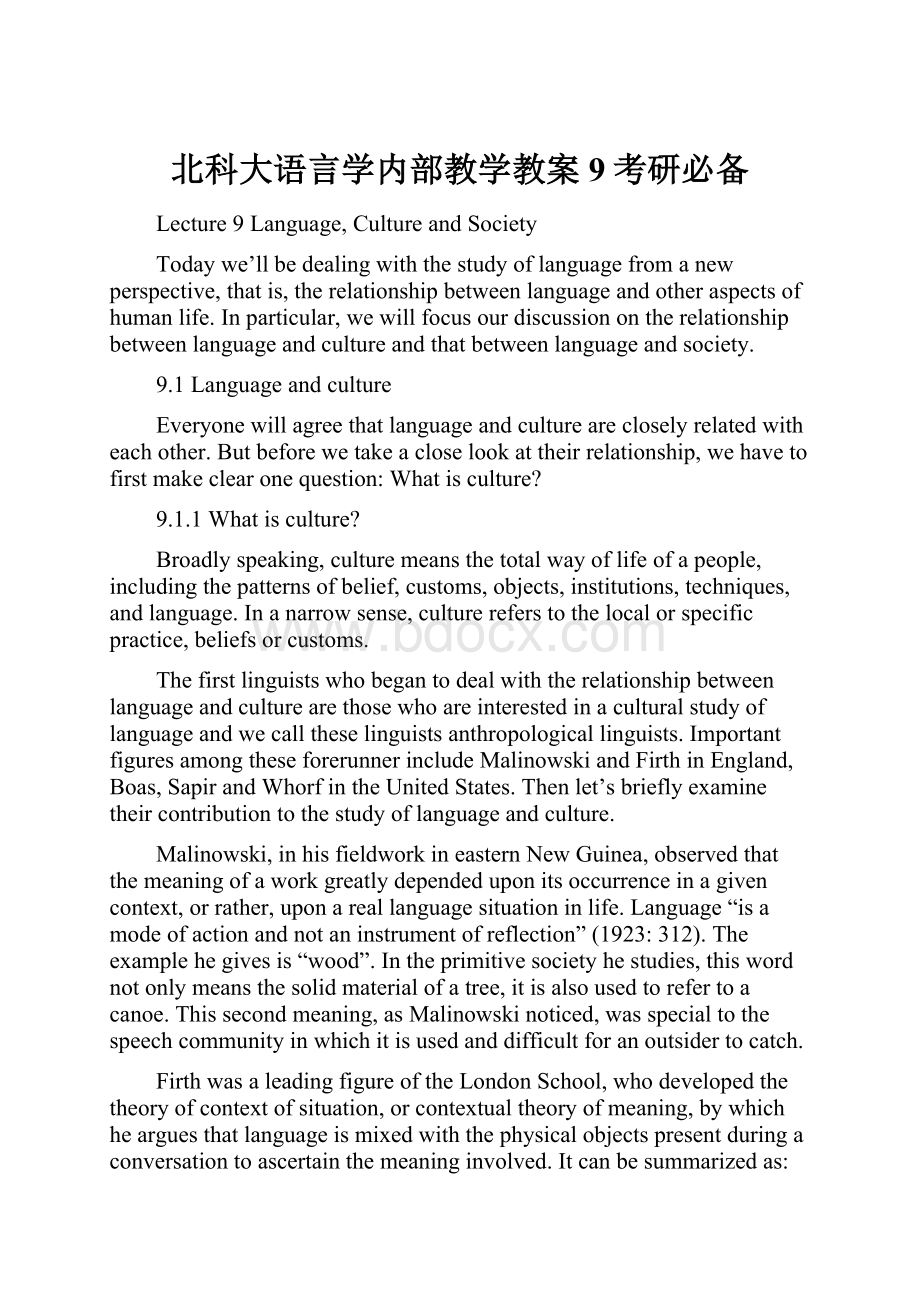北科大语言学内部教学教案9考研必备.docx
《北科大语言学内部教学教案9考研必备.docx》由会员分享,可在线阅读,更多相关《北科大语言学内部教学教案9考研必备.docx(12页珍藏版)》请在冰豆网上搜索。

北科大语言学内部教学教案9考研必备
Lecture9Language,CultureandSociety
Todaywe’llbedealingwiththestudyoflanguagefromanewperspective,thatis,therelationshipbetweenlanguageandotheraspectsofhumanlife.Inparticular,wewillfocusourdiscussionontherelationshipbetweenlanguageandcultureandthatbetweenlanguageandsociety.
9.1Languageandculture
Everyonewillagreethatlanguageandculturearecloselyrelatedwitheachother.Butbeforewetakeacloselookattheirrelationship,wehavetofirstmakeclearonequestion:
Whatisculture?
9.1.1Whatisculture?
Broadlyspeaking,culturemeansthetotalwayoflifeofapeople,includingthepatternsofbelief,customs,objects,institutions,techniques,andlanguage.Inanarrowsense,culturereferstothelocalorspecificpractice,beliefsorcustoms.
Thefirstlinguistswhobegantodealwiththerelationshipbetweenlanguageandculturearethosewhoareinterestedinaculturalstudyoflanguageandwecalltheselinguistsanthropologicallinguists.ImportantfiguresamongtheseforerunnerincludeMalinowskiandFirthinEngland,Boas,SapirandWhorfintheUnitedStates.Thenlet’sbrieflyexaminetheircontributiontothestudyoflanguageandculture.
Malinowski,inhisfieldworkineasternNewGuinea,observedthatthemeaningofaworkgreatlydependeduponitsoccurrenceinagivencontext,orrather,uponareallanguagesituationinlife.Language“isamodeofactionandnotaninstrumentofreflection”(1923:
312).Theexamplehegivesis“wood”.Intheprimitivesocietyhestudies,thiswordnotonlymeansthesolidmaterialofatree,itisalsousedtorefertoacanoe.Thissecondmeaning,asMalinowskinoticed,wasspecialtothespeechcommunityinwhichitisusedanddifficultforanoutsidertocatch.
FirthwasaleadingfigureoftheLondonSchool,whodevelopedthetheoryofcontextofsituation,orcontextualtheoryofmeaning,bywhichhearguesthatlanguageismixedwiththephysicalobjectspresentduringaconversationtoascertainthemeaninginvolved.Itcanbesummarizedas:
A.Therelevantfeaturesoftheparticipants:
persons,personalities:
(i)Theverbalactionoftheparticipants.
(ii)Thenonverbalactionoftheparticipants.
B.Therelevantobjects.
C.Theeffectsoftheverbalaction.
HereFirtharesuggestingtwothings:
1)Individualsuselanguagecreativelyandindifferentways;2)languageusedependsontheparticipants(whotowhom),thevariety(whatlanguage),thesituation(when)andpurpose(towhatend).
Thenifwewanttosummarizetherelationshipbetweenlanguageandculture,wemaysay:
Languageexpressesculturalreality,forexample,aluckydogvs.狗仗人势;languageembodiesculturalidentity,forexample,fromaperson’suseofcertainvocabulary,weknowwhereheisfrom;languagesymbolizesculturalreality,thatis,peopleareidentifiedbytheiruseoflanguage;languagehelpsperpetuatetheculture–itisthroughlanguagethatcultureispasseddownfromgenerationtogeneration,fromoneplacetoanother.Tosumup,wemaysaytherelationoflanguagetocultureisthatofparttowhole,forlanguageispartofculture.Theknowledgeandbeliefsthatconstituteapeople’sculturearehabituallyencodedandtransmittedinlanguage.
9.1.2TheSapir-Whorfhypothesis
NorthAmericananthropologicallinguistsmadetheircontributiontothestudyoflanguageandcultureintheireffortstoreconstructAmericannativelanguages,mostlyAmericanIndianlanguages.Firstlet’slookattheirpicturesandthenI’llsharewithyouthestoryaboutBenjaminLeeWhorf.
Whorf(1897~1941)wasachemicalengineerbyprofession.Hehadbeenworkingforaninsurancecompanysincehisgraduationfromcollegetillhisdeath.Hewasinchargeoffirecontroltechniques,particularlyhisjobwastofindoutthecausesoffire.Inhiswork,hefoundthattherewereobjectivecausesandalsosubjectivecauseswhichwasconcernedwithlanguageunderstanding.Forexample,nearthestorehouseswhichweremarked“gasolinedrums”(汽油罐),peopletendedtobeverycarefulwiththeirbehaviourinordernottosetfiretothem.However,nearthestorehousesmarked“emptygasolinedrums”(空油罐),peopletendedtobecomecasual,smokingandthrowingawaycigaretteends.Infact,“empty”gasolinedrumsareevenmoredangerousthan“full”ones,foremptyonesarefullofexplosivegas.Asalanguagemarker,“empty”doesn’tgivetheinformationofdanger.ManysimilarcasesdroveWhorftotherealizationthatlanguagehasmuchinfluenceandcontroloverthethinkingandbehaviourofhumanbeings.Therefore,dopeoplespeakingdifferentlanguagesthinkindifferentways.Hethusbecamemuchinterestedinlanguage,andbegantodoliteraturereviewandfieldworkonIndianlanguagesinhissparetime.In1931,whenthefamousanthropologicallinguistSapirwenttoteachinYaleUniversity,WhorfwentthereandstudiedthecoursesgivenbySapironAmericanIndianlanguagesandwiththelatter’ssupporthefurtheredhisstudiesondifferentIndianlanguages.
InhisinvestigationWhorffoundthatmanyIndianlanguagesarefundamentallydifferentfromIndo-EuropeanlanguagesrepresentedbyEnglish.Suchdifferencesinstructurecorrespondtodifferentwaysofperceivingtheworld.Forexample,Englishsentencesconsistoftwomainparts,thesubjectandthepredicate.Theexpressionofeverythingisdividedintoanagent(主体)andanaction(动作).SomeIndianlanguages,forexample,Hopi,doesn’tmakethissubject-predicatedivision,i.e.,anverbcanexistoroccurindependentofasubject.InEnglishwesayAlightflashed,whileinHopithesamemeaningisexpressedbyonesimplewordrehpi,flash(occurred).Theactionofflashingandtheagentoflightarecombinedtogether.WhatEnglishspeakerperceiveismainlyanactionwhiletheHopiperceivesthestate.
AnotherexamplecomesfromtheNootka,inwhichthereisnosuchthingasthedifferentpartsofspeech.Theonlysentencepatternissubjectandpredicatecombinedtogether.(ThepictureinLanguageandLogic.)ThereisasimpleNootkasentence“ti´imshya´isita´itlma.WhentranslatedintoEnglish,Heinvitespeopletoafeast,itdividesthedescriptionintoanagentHeandanactioninvites.ButintheoriginalNootka,thereisnotsuchdivision.
Thepictureshowsthatthetwodifferentlanguage,EnglishandNootka,cutthesamethingupdifferentlyandtheorderindescriptionisalsodifferent.Whorfbelievesthatasubject-predicatelanguageisinfactabipolarworldview.Throughlayersofanalysisandabstraction,thingsaredividedintosmallerandsmallerparticleswhileasubject-predicatecombinedsentencepatternisaholisticandsyntheticworldview.Thisdifferenceisworldviewisnotabstractedfromtheexternalworld,butpre-conditionedbydifferentlanguages.Peoplespeakingacertainlanguagewillhavetofollowthelogicofthislanguageintheirthinking.Theywillhavedifferentperceptionsoftheworldbecausetheyspeakdifferentlanguages.
AccordingtoWhorf,languageclassifiesitemsofexperiencedifferently.TheclasscorrespondingtoonewordandonethoughtinlanguageAmayberegardedbylanguageBastwoormoreclassescorrespondingtotwoormorewordsandthoughts.HerehegavetheexampleofHopiandEskimo.InEnglishwehave3respectivewordsforairplane,dragonflyandpilot,butinHopitheyarejustoneword:
MASA’YTAKA.InEnglish,wehaveonewordforsnow,butEskimohas3or4differentwordsforsnow.Upontheseobservationsheintroducedthelinguisticrelativityprinciple:
Allobserversarenotledbythesamephysicalevidencetothesamepictureoftheuniverse,unlesstheirlinguisticbackgroundsaresimilar,orcaninsomewaybecalibrated.Inanotherarticle“LinguisticsasanExactScience”publishedinDecember1940,hemadeamoreexplicitstatementoflinguisticrelativity:
Usersofmarkedlydifferentgrammarsarepointedbytheirgrammarstowarddifferenttypesofobservationsanddifferentevaluationsofexternallysimilaractsofobservation,andhencearenotequivalentasobserversbutmustarriveatsomewhatdifferentviewsoftheworld.
TheideasofWhorfcanbeconcludedtotwomainpoints.First,peoplespeakingdifferentlanguageshavedifferentthinkingpatterns.People’sperceptionoftheworldisrelativetothestructuresofthelanguagetheyspeak.Second,languagedeterminesthought.Thinkingcannottakeplaceindependentofthought.Theformeriscalled“linguisticrelativity”andthelatter“linguisticdeterminism.”LaterpeoplereferthetwoingeneralasWhorfianhypothesisorSapir-Whorfhypothesis,forthetheorywascompletedbyWhorfbydevelopingSapir’sideasandSapirsupportedandtookpartinhistheoreticalconstruction.
Theoriginalclaimsthehypothesissuggestshavebeencriticizedbymanylinguistsandtheyarereferredtoasthestrongversionofthehypothesis.Thisversionremainscontroversialaswellasinfluentialeventotoday.Thereisalsoamodifiedversionofthishypothesis,whichisgenerallyaccepted.Thisweakversiongoeslikethis:
Thereisacorrelationbetweenlanguage,culture,andthought,butthecross-culturaldifferencesthusproducinginourwaysofthinkingarerelative,ratherthancategorical.
9.1.3Linguisticevidenceofculturaldifferences
Sincelanguageandculturearecloselyrelatedwitheachother,theninwhataspectoflanguageusecanwefindculturaldifferences?
First,theaddressterms.ThinkaboutthewaysyouaddressyourChineseteachersandyourforeignteacher.Youmusthavebeentoldthatyoucannotaddressyourforeignteacherby“TeacherX”.Instead,yourforeignteachersmayhavetoldyoutoaddressthembytheirfirstname,whileyouwillneverdothistoyourChineseteachers.
Jennifer